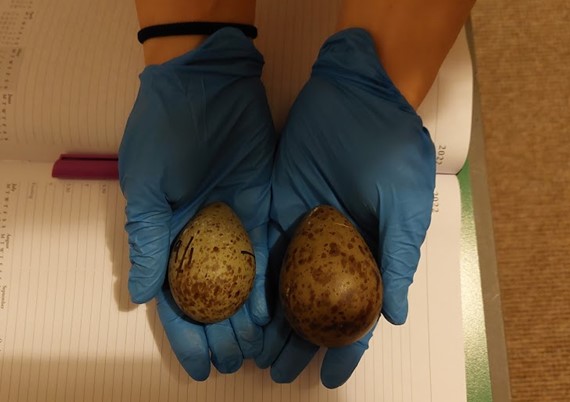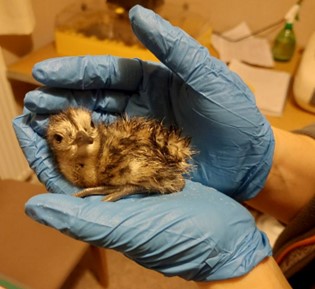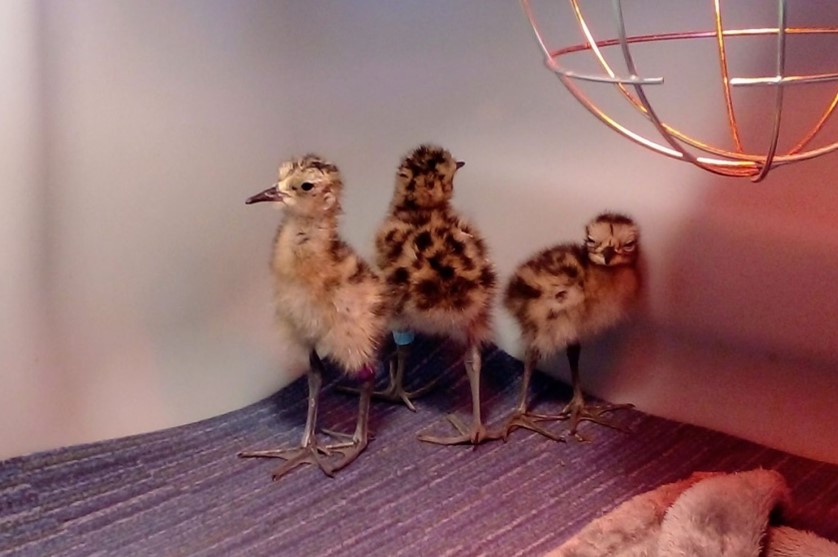It is not often that we name our Curlew chicks. For the most part we refer to them by their coloured band, preferring not to get overly attached to our small, fluffy charges. This does not in any way mean they do not present differing individual personality traits. As many of our volunteers will attest, we may often refer to certain birds by the odd behaviours we have come to associate them with. This all being said, I thought it time to tell you about our exception – Tiny Tim.
Tiny Tim’s egg came to us as the only one of its clutch, the nest sadly being lost soon after and another not located. Not a great start so far, but then our surprise at the size of this lone egg. I’m sure I’m not exaggerating when I say this is the smallest Curlew egg we have collected, weighing in at just 62.4g. For context, the average egg weight is around 79g, but the largest egg this season has come in at a whopping 94g!

During incubation we aim for the eggs to lose 15% of their weight by hatch time. This tiny egg continually lost too much weight, staying in our most humid incubator (where we hope to slow down the weight loss) for most of the process. Already a cause for concern, when it came to hatch time we were nervously watching and waiting to meet the small chick contained within.
When the chick finally hatched on the 7th of June (weighing just 42.5g!), we noticed that it still had a small portion of yolk sac external to its body. Usually this will be drawn inside the chick with the umbilicus sealing around it before hatching. With some yolk external and the seal incomplete we swabbed it generously with cleaning solution and made the decision to give it antibiotics in case any foreign substances were drawn inside the chick that could cause an infection. It’s first dose of antibiotics were administered that same evening via crop tube, with an additional dose of critical care formula, hoping to give the chick a boost. It was moved to the brooder and kept on its own at first, given dishes of the normal wet food and monitored closely.

The newly hatched Curlew chicks will not usually eat for the first 24-48 hours after hatching, instead surviving off the nutrients from the yolk sac. We would therefore expect to see a weight loss for the first day or so, followed by a continual increase. Unfortunately, we noticed that Tiny Tim was continuing to lose weight at an alarming rate – and none of the team had seen him trying to eat food from the dishes put out. We cautiously added other newly hatched chicks into his brooder, hoping to encourage him to eat, but he was continuously being outgrown and moved in with younger broods.
We made the decision to try feeding him by hand, on an hourly basis throughout the day. This started off with some pellets soaked in water, placed in his beak, just 3 or 4 at a time. A slow, time-consuming, and stressful process for all, we then trialled crushing the pellets into a paste and administering via crop tube. Although still difficult, it meant we could get more food into the chick with less effort and stress.

We weighed morning and evening, and watched his weight drop, 40g, 38, 36, 34… just 28g at his lowest. We almost lost hope, despite perking up after each feed, the weight simply was not going up. He finished his course of antibiotics, and the next morning his weight went up tentatively by 2g. A small ray of hope, were the dishes a little emptier? We stopped hand feeding and kept monitoring, moving him to younger broods for fear he would be bullied by the much larger chicks equal to his age.

At 9 days old, most of the chicks his age were already outside, foraging happily in the grass. Whilst he remained in a brooding tank for now, his weight had increased to 66g, seeming active and pretty feisty. We decided that if he had put on more weight the next day, we would take him outside with the youngest brood. Little did we know, this was only the first part of Tiny’s struggles, and he was not in the clear just yet…

